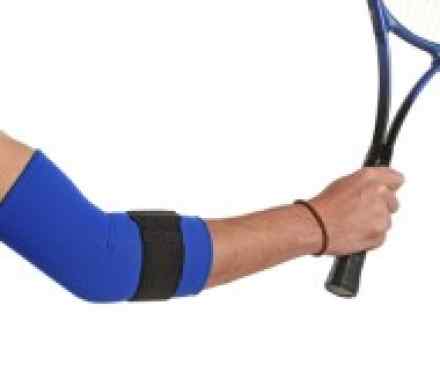
What is it?
Tennis elbow (lateral epicondylitis) is one of several overuse injuries that can affect your elbow. As you might assume, playing tennis is one cause of tennis elbow — but many other common activities can cause tennis elbow.
The pain of tennis elbow occurs primarily where the tendons of your forearm muscles attach to the bony prominence on the outside of your elbow (lateral epicondyle). Pain can also spread into your forearm and wrist.
The pain of tennis elbow doesn't have to keep you from enjoying your favorite activities. Rest and over-the-counter pain relievers often help. Rarely, surgery is needed.
Symptoms
Tennis elbow symptoms may include:
- Pain that radiates from the outside of your elbow into your forearm and wrist
- Pain when you extend your wrist
- Forearm weakness
- Pain that gets worse over weeks or months
- A painful grip during certain activities, such as shaking hands or turning a doorknob
- An inability to hold certain objects, such as a coffee cup
The pain of tennis elbow is similar to golfer's elbow. But golfer's elbow occurs on the inside — rather than on the outside — of your elbow.
Causes
Tennis elbow is an overuse injury. The cause is repeated contraction of the forearm muscles that you use to straighten and raise your hand and wrist. The repeated motions and stress to the tissue may result in inflammation or a series of tiny tears in the tendons that attach the forearm muscles to the bone at the outside of your elbow.
Risk factors
Tennis elbow is most common in adults ages 30 to 50 — but the condition can affect anyone who repetitively stresses the wrists.
Anyone who uses repetitive movements for at least two hours a day is at greater risk. People who smoke also have a higher risk of developing tennis elbow.
As the name tennis elbow indicates, playing tennis — particularly, repeated use of the backhand stroke with poor technique — is one possible cause of the condition. However, many other common arm motions, including using plumbing tools, painting, raking and weaving, can cause tennis elbow.
Complications
Left untreated, tennis elbow can result in chronic pain — especially when lifting or gripping objects. Using your arm too strenuously before your elbow has healed can make the problem worse.
Diagnosis
Your doctor may be able to diagnose tennis elbow by examining your elbow and based on your medical history. To evaluate pain and stiffness, your doctor may apply pressure to the affected area or ask you to move your elbow, wrist and fingers in various ways.
An X-ray can help your doctor rule out other possible causes of elbow pain, such as a fracture or arthritis. Rarely, more comprehensive imaging studies — such as ultrasound or magnetic resonance imaging (MRI) scans — are done.
References
http://www.hse.ie/eng/health/az/E/Epicondylitis/Treating-tennis-elbow.html
http://www.webmd.com/osteoarthritis/guide/tennis-elbow
http://www.nhs.uk/Conditions/Tennis-elbow/Pages/Introduction.aspx
http://www.mayoclinic.org/diseases-conditions/tennis-elbow/basics/definition/con-20043041

